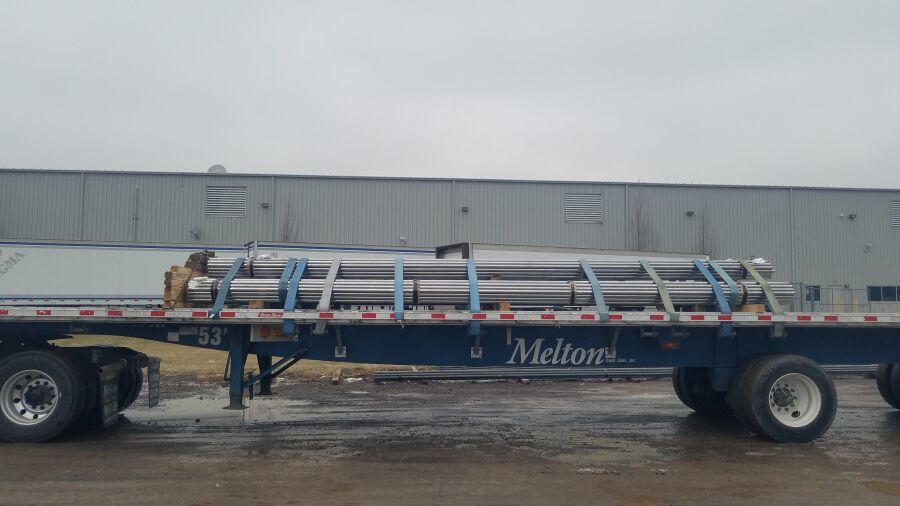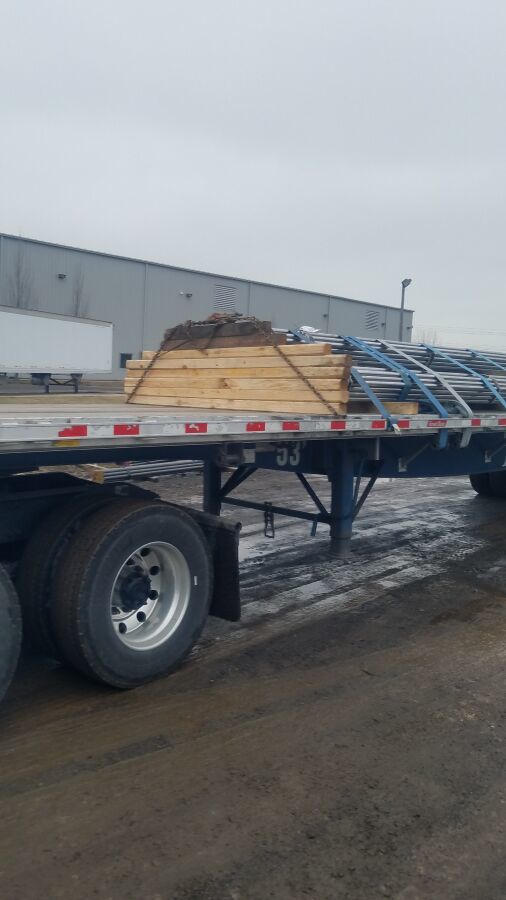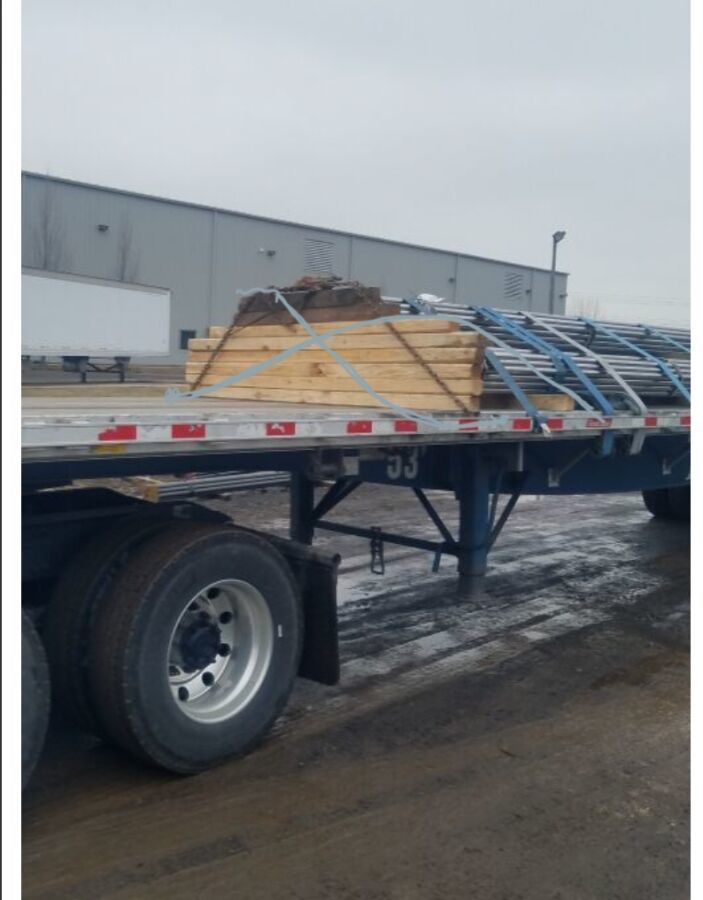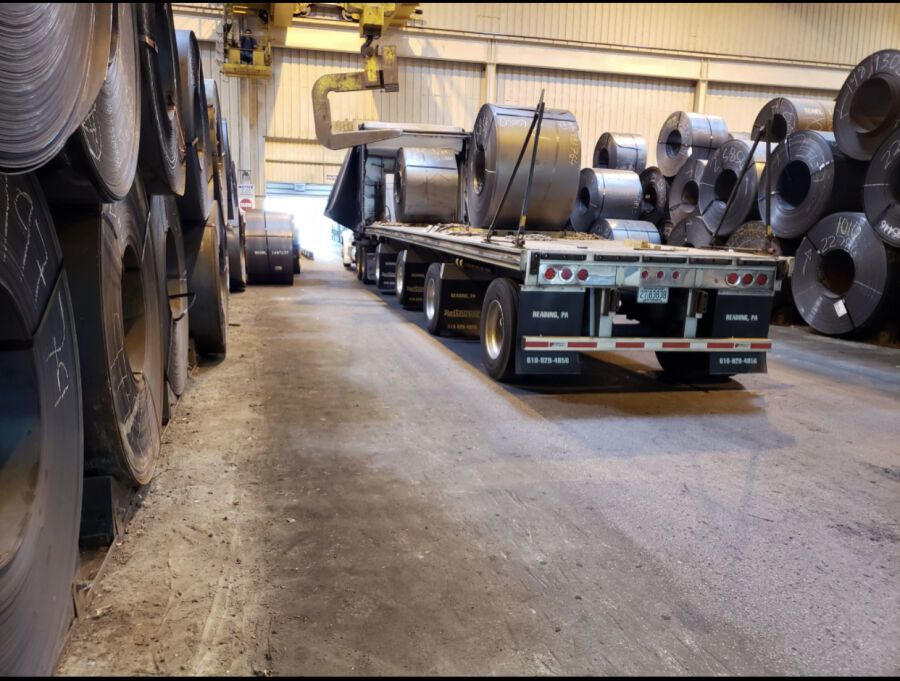Flatbed Securement Discussion 2022
Topic 31351 | Page 1
Fantastic idea with a great way to spread knowledge. This is what Brett had in mind when he started the site.
Thanks for this thread Chief. I hope all the flatbed drivers on this site will contribute on this thread.
As for your picture you just tighten the excess strap in between the strap and wood correct? Also meant to ask you , do you have winches on both sides of your trailer ?I kinda get the hint that you do. You put your stake pocket winches on the opposite side of the other winches for your loads? So for a load you have winches on both sides of the trailer correct?
Also how do you figure out how many straps to use on a load? I can't zoom in on your picture but it looks like you have 3 straps on the front powertrain unit. The way I do it is divide the weight of the load by 5 then 2 extra ones. I divide by 5 because the load straps are 5400lbs WLL, I round off.... The 2 extra straps are from I think Pianoman saying 1 more for your wife and 1 more for your kid.
The load I'm on now was 34,416lb. I used 9 straps for it. I had 4 stops, delivered to 3 of them and the remaining load is 8,174, or it should be according to the paperwork. I have 6 straps on that. 2 on the front, middle and back. I know that's overkill for that weight but I know for sure it's not going anywhere. It is also placed directly in the center of the trailer towards the front. I wanted to ask the forklift operator at the last stop if he could move it more towards the middle so it wouldn't be in the front. But I didn't. Any thoughts on the placement of the remaining load I have?
As for your picture you just tighten the excess strap in between the strap and wood correct?
Yup. It keeps the excess strap secure.
do you have winches on both sides of your trailer ?
Yes, Prime trailers have winches on both sides, giving you the ability to alternate the direction you pull your straps.
You put your stake pocket winches on the opposite side of the other winches for your loads? So for a load you have winches on both sides of the trailer correct?
You can put stake or portable winches wherever you want. In particular I liked to use them over the tires, which is somewhere you should never have a standard rail winch.
Some would consider your strap count a little overkill. But you can't put a price on the piece of mind of knowing your load is secure. I always shot for 100% securement as opposed to the required 50%. Meaning if a load weight 40,000 lbs, I'd have at least eight straps on it, and always an extra strap in the front and rear.
Also there are some loads that, although lightweight, require more straps simply due to the size and shape of the product. For example I once had an irrigation system (those long ones that spin around in a circle in a field) that weighed somewhere in the area of 20k-25k, but I had a record 26 straps on that load because of the pieces and parts scattered everywhere on my deck.
Overkill is good. The alternative is not.
HOS:
Hours Of Service
HOS refers to the logbook hours of service regulations.OWI:
Operating While Intoxicated
Oh yeah. As to your load placement question, I wouldn't bother moving it to go to the third stop. Something that light isn't going to make that much of a difference anyway. No need to create that unnecessary step, not to mention the liability the forklift operator would take on by touching someone else's freight.
I have a question. How would you all secure this load, on your own? Would you have done more bulk heads or side guards?


We did two belly wraps one in the front and rear of the load. 13 straps in total all rated at 4,000 lbs which this load weighs in at 43 or 45000 lbs so we way oversecured it but I know that you all have good ideas so I am looking forward to your ideas!
Also on a sidenote to moderators, can you take me off moderation lol, it would be nice for like updates on my diary and such.
The bulkhead looks a little too tall for me. The higher you go, the weaker it becomes. I'd prefer to have the boards side by side, three tiers high.
Also, I'd have a belly strap front and rear on the bottom tier of pipe. Not required, but quick and easy.
Bulkhead:
A strong wall-like structure placed at the front of a flatbed trailer (or on the rear of the tractor) used to protect the driver against shifting cargo during a front-end collision. May also refer to any separator within a dry or liquid trailer (also called a baffle for liquid trailers) used to partition the load.
The only thing that I add in that situation is to add 2 X chains across the front of the bulkhead. I don't actually use a binder to secure them. I just bungee the slack. The purpose is in case the load shifts forward I have two extra chains across the front that will catch the dunnage.

Bulkhead:
A strong wall-like structure placed at the front of a flatbed trailer (or on the rear of the tractor) used to protect the driver against shifting cargo during a front-end collision. May also refer to any separator within a dry or liquid trailer (also called a baffle for liquid trailers) used to partition the load.
Thank you for your imput will do that, my trainer says the reason we went that high was because we did not have enough boards to do 3 tiers high with them side by side.
Brody thats a grand idea thats something I will remember to do by myself although I have not gotten there yet. Nervous about doing chains on my own, mostly with coils cause I am not sure how to keep them up the bulk head when I am chaining. Any ideas?
The bulkhead looks a little too tall for me. The higher you go, the weaker it becomes. I'd prefer to have the boards side by side, three tiers high.
Also, I'd have a belly strap front and rear on the bottom tier of pipe. Not required, but quick and easy.
Bulkhead:
A strong wall-like structure placed at the front of a flatbed trailer (or on the rear of the tractor) used to protect the driver against shifting cargo during a front-end collision. May also refer to any separator within a dry or liquid trailer (also called a baffle for liquid trailers) used to partition the load.

Victor. As a guy who has hauled coils, many of them and very heavy (those two were 84k combined), I can tell you that you’re not going to use a bulkhead. Chaining coils is all about doing it properly and consistently and respecting that load for the potential hazards it poses. A bulkhead made of a few 4x4’s isn’t going to stop a coil if it gets loose, not much will.
Bulkhead:
A strong wall-like structure placed at the front of a flatbed trailer (or on the rear of the tractor) used to protect the driver against shifting cargo during a front-end collision. May also refer to any separator within a dry or liquid trailer (also called a baffle for liquid trailers) used to partition the load.
HOS:
Hours Of Service
HOS refers to the logbook hours of service regulations.OOS:
When a violation by either a driver or company is confirmed, an out-of-service order removes either the driver or the vehicle from the roadway until the violation is corrected.
New Reply:
New! Check out our help videos for a better understanding of our forum features

















Preview:
This topic has the following tags:
Flatbed Load Securement Photos Trailers Trip Planning Truck Driver Safety Truck Driver Training







 TT On Facebook
TT On Facebook
Rather than continue to hijack Twosides's diary, I am starting this thread for him, or other rookie flatbed drivers, to ask questions about securement and for myself, and other experienced flatbed drivers to offer advice.
Hopefully, Twosides will have gotten someone at Knight to provide direct training, which is a lot better, but even with that this thread should be helpful.
Below is my latest load of Caterpillar lower powertrain units.
This is an example of how to use the excess strap as edge protection.